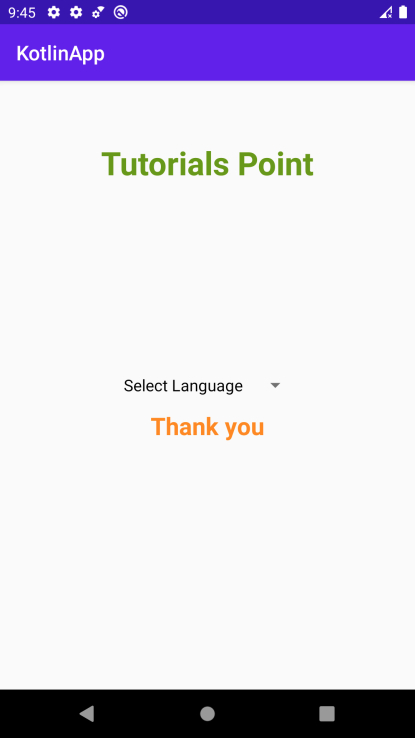使用者使用 Kotlin 選擇語言後,如何更改應用的語言?
此示例演示了使用者使用 Kotlin 選擇語言時如何更改應用的語言。
步驟 1 − 在 Android Studio 中建立一個新專案,轉到檔案?新建專案,並填寫所有必要的資訊以建立一個新專案。
步驟 2 − 將以下程式碼新增到 res/layout/activity_main.xml 中。
示例
<?xml version="1.0" encoding="utf-8"?> <RelativeLayout xmlns:android="http://schemas.android.com/apk/res/android" xmlns:tools="http://schemas.android.com/tools" android:id="@+id/rl" android:layout_width="match_parent" android:layout_height="match_parent" android:padding="10dp" tools:context=".MainActivity"> <TextView android:layout_width="wrap_content" android:layout_height="wrap_content" android:layout_centerHorizontal="true" android:layout_marginTop="50dp" android:text="Tutorials Point" android:textAlignment="center" android:textColor="@android:color/holo_green_dark" android:textSize="32sp" android:textStyle="bold" /> <Spinner android:id="@+id/spinner" android:layout_width="wrap_content" android:layout_height="wrap_content" android:layout_centerInParent="true" /> <TextView android:id="@+id/string" android:layout_width="wrap_content" android:layout_height="wrap_content" android:layout_below="@id/spinner" android:layout_centerInParent="true" android:text="@string/thank_you" android:textColor="@android:color/holo_orange_dark" android:textSize="24sp" android:textStyle="bold" /> </RelativeLayout>
步驟 3 − 將以下程式碼新增到 src/MainActivity.kt 中
import android.content.Intent
import android.os.Bundle
import android.view.View
import android.widget.AdapterView
import android.widget.AdapterView.OnItemSelectedListener
import android.widget.ArrayAdapter
import android.widget.Spinner
import android.widget.Toast
import androidx.appcompat.app.AppCompatActivity
import java.util.*
import kotlin.system.exitProcess
@Suppress("DEPRECATION")
class MainActivity : AppCompatActivity() {
lateinit var spinner: Spinner
lateinit var locale: Locale
private var currentLanguage = "en"
private var currentLang: String? = null
override fun onCreate(savedInstanceState: Bundle?) {
super.onCreate(savedInstanceState)
setContentView(R.layout.activity_main)
title = "KotlinApp"
currentLanguage = intent.getStringExtra(currentLang).toString()
spinner = findViewById(R.id.spinner)
val list = ArrayList<String>()
list.add("Select Language")
list.add("English")
list.add("Español")
list.add("Français")
list.add("Hindi")
val adapter = ArrayAdapter(this, R.layout.support_simple_spinner_dropdown_item, list)
adapter.setDropDownViewResource(android.R.layout.simple_spinner_dropdown_item)
spinner.adapter = adapter
spinner.onItemSelectedListener = object : OnItemSelectedListener {
override fun onItemSelected(parent: AdapterView<*>, view: View, position: Int, id: Long) {
when (position) {
0 -> {
}
1 -> setLocale("en")
2 -> setLocale("es")
3 -> setLocale("fr")
4 -> setLocale("hi")
}
}
override fun onNothingSelected(parent: AdapterView<*>) {}
}
}
private fun setLocale(localeName: String) {
if (localeName != currentLanguage) {
locale = Locale(localeName)
val res = resources
val dm = res.displayMetrics
val conf = res.configuration
conf.locale = locale
res.updateConfiguration(conf, dm)
val refresh = Intent(
this,
MainActivity::class.java
)
refresh.putExtra(currentLang, localeName)
startActivity(refresh)
} else {
Toast.makeText(
this@MainActivity, "Language, , already, , selected)!", Toast.LENGTH_SHORT).show();
}
}
override fun onBackPressed() {
val intent = Intent(Intent.ACTION_MAIN)
intent.addCategory(Intent.CATEGORY_HOME)
intent.flags = Intent.FLAG_ACTIVITY_CLEAR_TOP
startActivity(intent)
finish()
exitProcess(0)
}
}步驟 4 − 建立 values-es、values-fr、values-hi 並新增以下程式碼 −
values-hi/strings.xml
<?xml version="1.0" encoding="utf-8"?> <resources> <string name="app_name">Sample</string> <string name="thank_you">???????</string> </resources>
values-es/strings.xml
<?xml version="1.0" encoding="utf-8"?> <resources> <string name="app_name">Sample</string> <string name="thank_you">Gracias</string> </resources>
values-fr/strings.xml
<?xml version="1.0" encoding="utf-8"?> <resources> <string name="app_name">Sample</string> <string name="thank_you">Je vous remercie</string> </resources>
values/strings.xml
<resources> <string name="app_name">Your App Name</string> <string name="thank_you">Thank you</string> </resources>
步驟 5 − 將以下程式碼新增到 androidManifest.xml 中
<?xml version="1.0" encoding="utf-8"?> <manifest xmlns:android="http://schemas.android.com/apk/res/android" package="com.example.q11"> <application android:allowBackup="true" android:icon="@mipmap/ic_launcher" android:label="@string/app_name" android:roundIcon="@mipmap/ic_launcher_round" android:supportsRtl="true" android:theme="@style/AppTheme"> <activity android:name=".MainActivity"> <intent-filter> <action android:name="android.intent.action.MAIN" /> <category android:name="android.intent.category.LAUNCHER" /> </intent-filter> </activity> </application> </manifest>
讓我們嘗試執行您的應用程式。我假設您已將您的實際 Android 移動裝置連線到您的計算機。要從 Android Studio 執行應用程式,請開啟您的一個專案活動檔案,然後單擊執行圖示![]() 從工具欄中。選擇您的移動裝置作為選項,然後檢查您的移動裝置,它將顯示您的預設螢幕
從工具欄中。選擇您的移動裝置作為選項,然後檢查您的移動裝置,它將顯示您的預設螢幕




廣告

 資料結構
資料結構 網路
網路 關係資料庫管理系統
關係資料庫管理系統 作業系統
作業系統 Java
Java iOS
iOS HTML
HTML CSS
CSS Android
Android Python
Python C 程式設計
C 程式設計 C++
C++ C#
C# MongoDB
MongoDB MySQL
MySQL Javascript
Javascript PHP
PHP